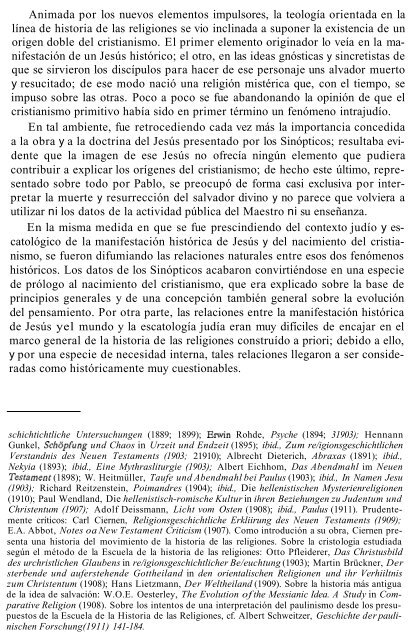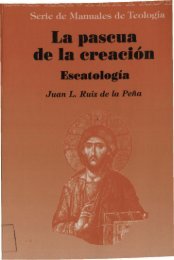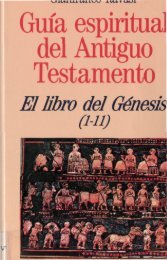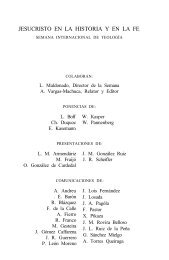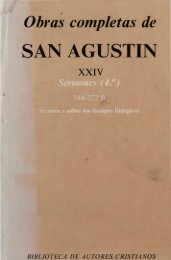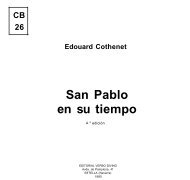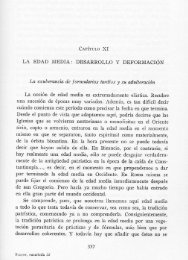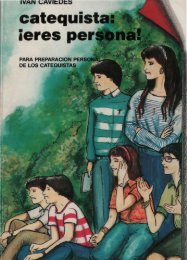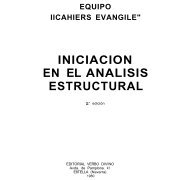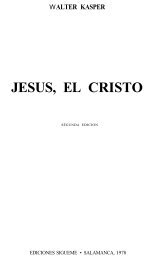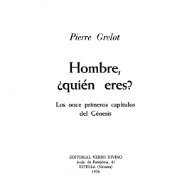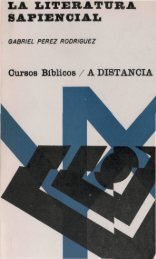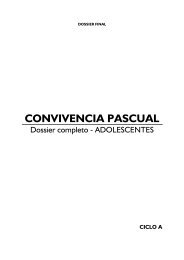investigación sobre la vida de jesús - bibliotecacatolicadigital.org
investigación sobre la vida de jesús - bibliotecacatolicadigital.org
investigación sobre la vida de jesús - bibliotecacatolicadigital.org
Create successful ePaper yourself
Turn your PDF publications into a flip-book with our unique Google optimized e-Paper software.
Animada por los nuevos elementos impulsores, <strong>la</strong> teología orientada en <strong>la</strong>línea <strong>de</strong> historia <strong>de</strong> <strong>la</strong>s religiones se vio inclinada a suponer <strong>la</strong> existencia <strong>de</strong> unorigen doble <strong>de</strong>l cristianismo. El primer elemento originador lo veía en <strong>la</strong> manifestación<strong>de</strong> un Jesús histórico; el otro, en <strong>la</strong>s i<strong>de</strong>as gnósticas y sincretistas <strong>de</strong>que se sirvieron los discípulos para hacer <strong>de</strong> ese personaje uns alvador muertoy resucitado; <strong>de</strong> ese modo nació una religión mistérica que, con el tiempo, seimpuso <strong>sobre</strong> <strong>la</strong>s otras. Poco a poco se fue abandonando <strong>la</strong> opinión <strong>de</strong> que elcristianismo primitivo había sido en primer término un fenómeno intrajudío.En tal ambiente, fue retrocediendo cada vez más <strong>la</strong> importancia concedidaa <strong>la</strong> obra y a <strong>la</strong> doctrina <strong>de</strong>l Jesús presentado por los Sinópticos; resultaba evi<strong>de</strong>nteque <strong>la</strong> imagen <strong>de</strong> ese Jesús no ofrecía ningún elemento que pudieracontribuir a explicar los orígenes <strong>de</strong>l cristianismo; <strong>de</strong> hecho este último, representado<strong>sobre</strong> todo por Pablo, se preocupó <strong>de</strong> forma casi exclusiva por interpretar<strong>la</strong> muerte y resurrección <strong>de</strong>l salvador divino y no parece que volviera autilizar ni los datos <strong>de</strong> <strong>la</strong> acti<strong>vida</strong>d pública <strong>de</strong>l Maestro ni su enseñanza.En <strong>la</strong> misma medida en que se fue prescindiendo <strong>de</strong>l contexto judío y escatológico<strong>de</strong> <strong>la</strong> manifestación histórica <strong>de</strong> Jesús y <strong>de</strong>l nacimiento <strong>de</strong>l cristianismo,se fueron difumiando <strong>la</strong>s re<strong>la</strong>ciones naturales entre esos dos fenómenoshistóricos. Los datos <strong>de</strong> los Sinópticos acabaron convirtiéndose en una especie<strong>de</strong> prólogo al nacimiento <strong>de</strong>l cristianismo, que era explicado <strong>sobre</strong> <strong>la</strong> base <strong>de</strong>principios generales y <strong>de</strong> una concepción también general <strong>sobre</strong> <strong>la</strong> evolución<strong>de</strong>l pensamiento. Por otra parte, <strong>la</strong>s re<strong>la</strong>ciones entre <strong>la</strong> manifestación histórica<strong>de</strong> Jesús yel mundo y <strong>la</strong> escatología judía eran muy difíciles <strong>de</strong> encajar en elmarco general <strong>de</strong> <strong>la</strong> historia <strong>de</strong> <strong>la</strong>s religiones construído a priori; <strong>de</strong>bido a ello,y por una especie <strong>de</strong> necesidad interna, tales re<strong>la</strong>ciones llegaron a ser consi<strong>de</strong>radascomo históricamente muy cuestionables.schichtichtliche Untersuchungen (1889; 1899); Etwin Roh<strong>de</strong>, Psyche (1894; 31903); HennannGunkel, SchOpfung und Chaos in Urzeit und Endzeit (1895); ibid., Zum re/igionsgeschichtlichenVerstandnis <strong>de</strong>s Neuen Testaments (1903; 21910); Albrecht Dieterich, Abraxas (1891); ibid.,Nekyia (1893); ibid., Eine Mythrasliturgie (1903); Albert Eichhom, Das Abendmahl im NeuenTestament (1898); W. Heitmüller, Taufe und Abendmahl bei Paulus (1903); ibid., In Namen Jesu(1903); Richard Reitzenstein, Poimandres (1904); ibid., Die hellenistischen Mysterienreligionen(1910); Paul Wend<strong>la</strong>nd, Die hellenistisch-romische Kultur in ihren Beziehungen zu Ju<strong>de</strong>ntum undChristentum (1907); Adolf Deissmann, Licht vom Osten (1908); ibid., Paulus (1911). Pru<strong>de</strong>ntementecríticos: Carl Ciernen, Religionsgeschichtliche Erkliirung <strong>de</strong>s Neuen Testaments (1909);E.A. Abbot, Notes oaNew Testament Criticism (1907). Como introdución a su obra, Ciernen presentauna historia <strong>de</strong>l movimiento <strong>de</strong> <strong>la</strong> historia <strong>de</strong> <strong>la</strong>s religiones. Sobre <strong>la</strong> cristologia estudiadasegún el método <strong>de</strong> <strong>la</strong> Escue<strong>la</strong> <strong>de</strong> <strong>la</strong> historia <strong>de</strong> <strong>la</strong>s religiones: Otto Pflei<strong>de</strong>rer, Das Christusbild<strong>de</strong>s urchristlichen G<strong>la</strong>ubens in re/igionsgeschichtlicher Be/euchtung (1903); Martin Brückner, Dersterben<strong>de</strong> und auferstehen<strong>de</strong> Gotthei<strong>la</strong>nd in <strong>de</strong>n orientalischen Religionen und ihr Verhiiltniszum Christentum (1908); Hans Lietzmann, Der Welthei<strong>la</strong>nd (1909). Sobre <strong>la</strong> historia más antigua<strong>de</strong> <strong>la</strong> i<strong>de</strong>a <strong>de</strong> salvación: W.O.E. Oesterley, The Evolution ofthe Messianic I<strong>de</strong>a. A Study in ComparativeReligion (1908). Sobre los intentos <strong>de</strong> una interpretación <strong>de</strong>l paulinismo <strong>de</strong>s<strong>de</strong> los presupuestos<strong>de</strong> <strong>la</strong> Escue<strong>la</strong> <strong>de</strong> <strong>la</strong> Historia <strong>de</strong> <strong>la</strong>s Religiones, cf. Albert Schweitzer, Geschichte <strong>de</strong>rpaulinischenForschung(1911) 141-184.


